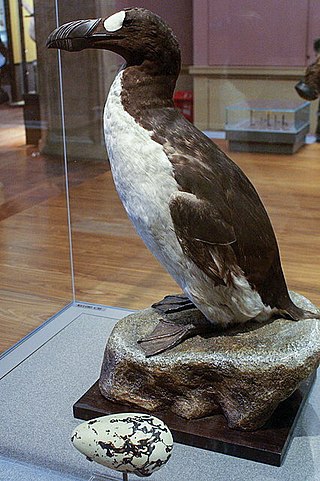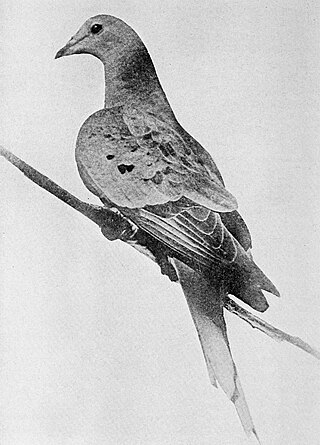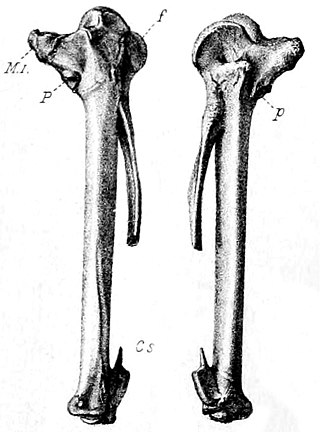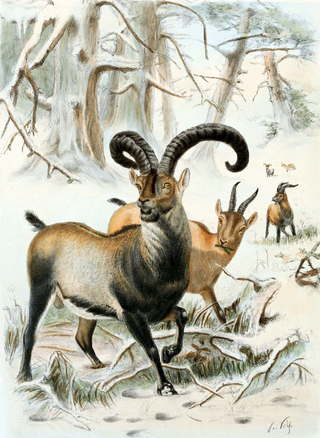
The Carolina parakeet, or Carolina conure, is an extinct species of small green neotropical parrot with a bright yellow head, reddish orange face, and pale beak that was native to the Eastern, Midwest, and Plains states of the United States. It was the only indigenous parrot within its range, as well as one of only three parrot species native to the United States. It was called puzzi la née or pot pot chee by the Seminole and kelinky in Chickasaw. Though formerly prevalent within its range, the bird had become rare by the middle of the 19th century. The last confirmed sighting in the wild was of the C. c. ludovicianus subspecies in 1910. The last known specimen, a male named Incas, perished in captivity at the Cincinnati Zoo in 1918, and the species was declared extinct in 1939.

The dodo is an extinct flightless bird that was endemic to the island of Mauritius, which is east of Madagascar in the Indian Ocean. The dodo's closest relative was the also-extinct and flightless Rodrigues solitaire. The two formed the subfamily Raphinae, a clade of extinct flightless birds that were a part of the family which includes pigeons and doves. The closest living relative of the dodo is the Nicobar pigeon. A white dodo was once thought to have existed on the nearby island of Réunion, but it is now believed that this assumption was merely confusion based on the also-extinct Réunion ibis and paintings of white dodos.

The great auk is a species of flightless alcid that became extinct in the mid-19th century. It was the only modern species in the genus Pinguinus. It is not closely related to the Southern Hemisphere birds now known as penguins, which were discovered later by Europeans and so named by sailors because of their physical resemblance to the great auk, which were called penguins.

Columbidae is a bird family consisting of doves and pigeons. It is the only family in the order Columbiformes. These are stout-bodied birds with short necks and short slender bills that in some species feature fleshy ceres. They primarily feed on plants, and can be taxonomically divided amongst granivores, that feed mostly on the ground on seeds, and frugivores, that feed mostly on fruits, from branches. The family occurs worldwide, often in close proximity with humans, but the greatest variety is in the Indomalayan and Australasian realms.

Rails are a large, cosmopolitan family of small- to medium-sized terrestrial and/or semi-amphibious birds. The family exhibits considerable diversity in its forms, and includes such ubiquitous species as the crakes, coots, and gallinule; other rail species are extremely rare or endangered. Many are associated with wetland habitats, some being semi-aquatic like waterfowl, but many more are wading birds or shorebirds. The ideal rail habitats are marsh areas, including rice paddies, and flooded fields or open forest. They are especially fond of dense vegetation for nesting. The rail family is found in every terrestrial habitat with the exception of dry desert, polar or freezing regions, and alpine areas. Members of Rallidae occur on every continent except Antarctica. Numerous unique island species are known.

The Réunion ibis or Réunion sacred ibis is an extinct species of ibis that was endemic to the volcanic island of Réunion in the Indian Ocean. The first subfossil remains were found in 1974, and the ibis was first scientifically described in 1987. Its closest relatives are the Malagasy sacred ibis, the African sacred ibis, and the straw-necked ibis. Travellers' accounts from the 17th and 18th centuries described a white bird on Réunion that flew with difficulty and preferred solitude, which was subsequently referred to as the "Réunion solitaire".

Flightless birds are birds that, through evolution, lost the ability to fly. There are over 60 extant species, including the well-known ratites and penguins. The smallest flightless bird is the Inaccessible Island rail. The largest flightless bird, which is also the largest living bird in general, is the common ostrich.

The pink pigeon is a species of pigeon in the family Columbidae endemic to Mauritius. The pink pigeon nearly became extinct in the 1970s and the 1990s and is still very rare. It is the only Mascarene pigeon that has not become extinct. It was on the brink of extinction in 1991 when only 10 individuals remained, but its numbers have increased due to the efforts of the Durrell Wildlife Conservation Trust since 1977. While the population remains at below 500 birds as of 2011, the IUCN downlisted the species from Critically endangered to Endangered on the IUCN Red List in 2000, and then downlisted it again to Vulnerable in 2018.

The Raphinae are a clade of extinct flightless birds formerly called didines or didine birds. They inhabited the Mascarene Islands of Mauritius and Rodrigues, but became extinct through hunting by humans and predation by introduced non-native mammals following human colonisation in the 17th century. Historically, many different groups have been named for both the dodo and the Rodrigues solitaire, not all grouping them together. Most recently, it is considered that the two birds can be classified in Columbidae, often under the subfamily Raphinae. The first person to suggest a close affinity to the doves was Johannes Theodor Reinhardt, whose opinions were then supported by Hugh Edwin Strickland and Alexander Gordon Melville.

Martha was a passenger pigeon, the last known of her species; she was named "Martha" in honor of Martha Washington, the first lady of the United States from 1789 to 1797.

The Mauritius sheldgoose, also known as the Mauritius shelduck, is an extinct species of sheldgoose that was endemic to the island of Mauritius. While geese were mentioned by visitors to Mauritius in the 17th century, few details were provided by these accounts. In 1893, a carpometacarpus wing-bone and a pelvis from the Mare aux Songes swamp were used to name a new species of comb duck, Sarcidiornis mauritianus. These bones were connected to the contemporary accounts of geese and later determined to belong to a species related to the Egyptian goose and placed in the sheldgoose genus Alopochen. The Mauritius and Réunion sheldgoose may have descended from Egyptian geese that colonised the Mascarene islands.

The tooth-billed pigeon, also known as the manumea, is a large pigeon found only in Samoa. It is the only living species of genus Didunculus. A related extinct species, the Tongan tooth-billed pigeon, is only known from subfossil remains in several archeological sites in Tonga. The tooth-billed pigeon is the national bird of Samoa and featured on the 20 tālā bills and the 50 sene pieces of the 2008/2011 series. Native only to Samoa's primary rainforest, it is considered to be endangered, with only a few hundred individuals thought to remain in existence.

Bird conservation is a field in the science of conservation biology related to threatened birds. Humans have had a profound effect on many bird species. Over one hundred species have gone extinct in historical times, although the most dramatic human-caused extinctions occurred in the Pacific Ocean as humans colonised the islands of Melanesia, Polynesia and Micronesia, during which an estimated 750–1,800 species of birds became extinct. According to Worldwatch Institute, many bird populations are currently declining worldwide, with 1,200 species facing extinction in the next century. The biggest cited reason surrounds habitat loss. Other threats include overhunting, accidental mortality due to structural collisions, long-line fishing bycatch, pollution, competition and predation by pet cats, oil spills and pesticide use and climate change. Governments, along with numerous conservation charities, work to protect birds in various ways, including legislation, preserving and restoring bird habitat, and establishing captive populations for reintroductions.

Ducula is a genus of the pigeon family Columbidae, collectively known as imperial pigeons. They are large to very large pigeons with a heavy build and medium to long tails. They are arboreal, feed mainly on fruit and are closely related to the other genus of fruit-eating doves, Ptilinopus. Both genera display brightly coloured plumage, predominantly green, often with contrasting under-parts of purple, orange or red. Some Ducula have prominently swollen ceres. They have large gapes and swallow seeds whole, playing an important role in seed dispersal.

An endling is the last known individual of a species or subspecies. Once the endling dies, the species becomes extinct. The word was coined in correspondence in the scientific journal Nature.

The Mascarene grey parakeet, Mauritius grey parrot, or Thirioux's grey parrot, is an extinct species of parrot which was endemic to the Mascarene Islands of Mauritius and Réunion in the western Indian Ocean. It has been classified as a member of the tribe Psittaculini, along with other parrots from the Islands.

Julian Pender Hume is an English palaeontologist, artist and writer who lives in Wickham, Hampshire. He was born in Ashford, Kent, and grew up in Portsmouth, England.

New Zealand is geographically isolated, and originally lacked any mammalian predators, hence parrots evolved to fill habitats from the ground dwelling kākāpō to the alpine dwelling kea as well as a variety of forest species. The arrival of Māori, then European settlers with their attendant animals, habitat destruction and even deliberate targeting, has resulted in their numbers plummeting. Today one species is on the brink of extinction and three other species range from Vulnerable to Critically Endangered, all impacted by invasive species. Further parrot species were not introduced by acclimatisation societies, but occasional releases, both deliberate and accidental, have resulted in self-sustaining populations of some Australian species. New Zealand was identified among the highest priority countries for parrot conservation in the world, due to its parrot diversity, endemism, threats, and having more threatened parrot species than expected.

De-extinction is the process of generating an organism that either resembles or is an extinct species. There are several ways to carry out the process of de-extinction. Cloning is the most widely proposed method, although genome editing and selective breeding have also been considered. Similar techniques have been applied to certain endangered species, in hopes to boost their genetic diversity. The only method of the three that would provide an animal with the same genetic identity is cloning. There are benefits and drawbacks to the process of de-extinction ranging from technological advancements to ethical issues.
























